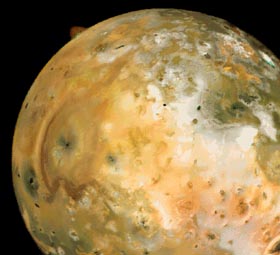
![]() Main Page
Main Page
![]() Feedback
Feedback
 The Author
The Author
 News
News
 Search
Search
 The Planets
The Planets
 Mercury
Mercury
 Venus
Venus
 Earth
Earth
 Mars
Mars
 Jupiter
Jupiter
 Saturn
Saturn
 Uranus
Uranus
 Neptune
Neptune
 Pluto
Pluto
 Dwarf Planets
Dwarf Planets
 The Solar System
The Solar System
 The Sun
The Sun
 The Moon
The Moon
 Meteors
Meteors
 Comets
Comets
 Asteroids
Asteroids
 Amazing facts
Amazing facts
 Other
Resources
Other
Resources
 Poster Store
Poster Store
 Multimedia
Multimedia
 Links
Links
 Awards
Awards
 Glossary
Glossary
 Astronomers
Astronomers
 Webrings
Webrings
 Bibliography
Bibliography

Technical Data:-
| Diameter | 3,630km |
| Average Distance from Jupiter | 421,600km |
| Average surface Temperature | 130K |
| Length of Day | 1.026 days(Phobos) 1.026 days(Deimos) |
| Length of Year | 0.3191(Phobos) 1.26244(Deimos) |
| Eccentricity of Orbit | 0.0041 |
| Density | 3.57 g/cm3(Phobos) |
| Mass | 8.94x10^22 |
More pictures of Io Here |
|||
Discovered by the Italian astronomer Galileo Galilei in 1610, Io is the innermost of the Galilean satellites of Jupiter, and certainly one of the most interesting moons in the Solar System. Whilst it is almost certainly devoid of any sort of life, it is a moon which one would struggle to define as 'dead'. This is because, unlike the dull grey mass that is our moon, Io is the most geologically active body in the solar system. It is awash with volcanoes and lava flows, experiencing volcanic eruptions to put the most destructive that the Earth can offer to shame. Visually it is one of the most distinctive and eye-catching bodies in the solar system, with an uneven surface strewn with craters and volcanoes. Orbit and Tidal Forces
One interesting feature about Io, which is the main cause of its geological activity, is the closeness of its orbit with Jupiter. With an average orbital radius of just 421,600km, Io lies almost as close to the surface of Jupiter's atmosphere as the moon does to Earth (384,400km). This is extremely close when one considers Jupiter's massively larger volume and mass. Io is locked into a resonant orbit around Jupiter with two other big moons, Europa and Ganymede. A consequence of the closeness of Io's orbit to Jupiter, coupled with the interferences of these other two moons is that Io is subjected to huge tidal forces (these occur when different bodies, in this case Jupiter, Europa and Ganymede, exert a gravitational pull on a planet from different directions). These forces can generate large amounts of heat and energy, and it is this which is thought to power the moon's volcanic activity. A consequence of these forces is that the surface of Io is regularly raised and lowered by a maximum of 100 metres, depending on the tide. Effects of Jupiter's Magnetosphere The proximity of Io's orbit to Jupiter also affects the big planet's magnetic field. For as Jupiter's magnetosphere rotates around the planet, it takes away almost 1,000kg of material (mainly volcanic gases) per second from Io. This matter, travelling outwards, causes the Jovian magnetosphere to double in size, compared to what would be expected if Io were not present. Furthermore, as a conductor travelling through Jupiter's magnetic field, an electromotive force is induced across Io of about 400kV in size, causing an electric current of 3 million Amps to flow through the paths of least resistance, along Jupiter's magnetic field lines, eventually resulting in lightning as it reaches the upper atmosphere of Jupiter. Images sent back by both the Voyager and Galileo spacecraft, as well as recent ground-based observations, showed us the extent of Io's volcanic activity. Images have shown volcanoes with plumes as high as 300km, ejecting debris at speeds of up to 1km per second (20 times faster than the most powerful volcano on Earth). Volcanoes have also been seen to stop ejecting materials, whilst others have flared up, within the space of mere weeks. |
|||
